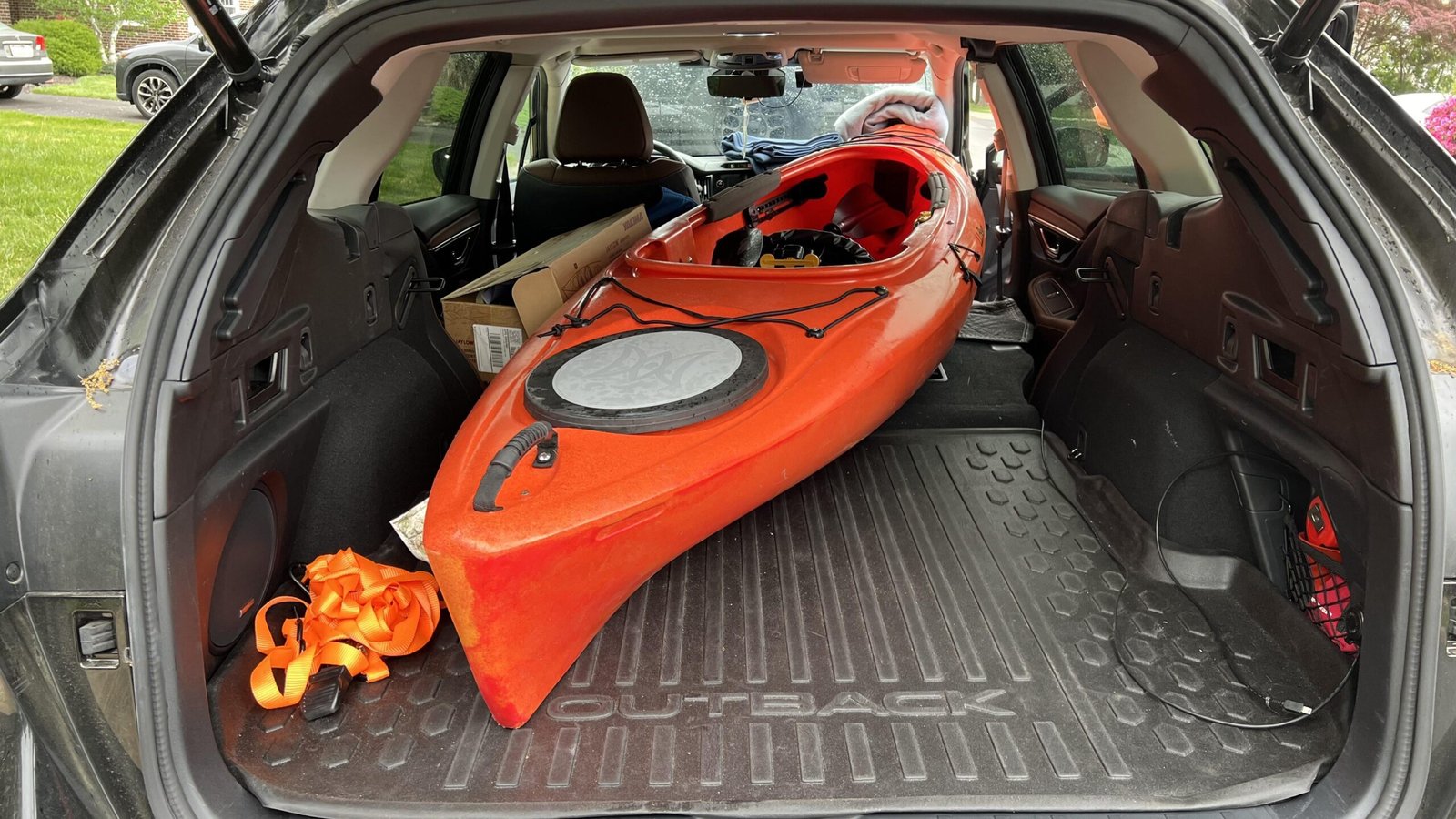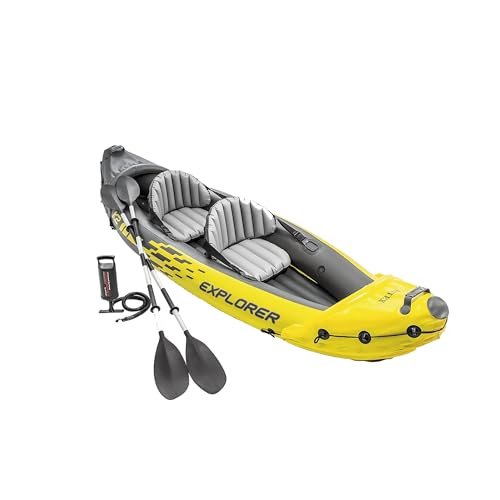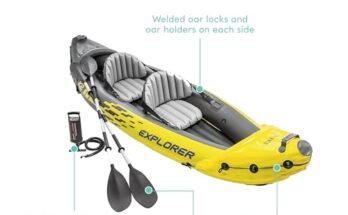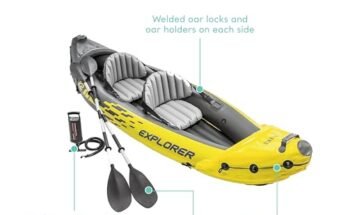Have you ever wondered if your kayak can fit inside your car? It’s a common question for anyone who loves hitting the water but wants to avoid the hassle of roof racks or trailers.
Knowing whether your kayak fits inside your vehicle can save you time, effort, and even money. You’ll discover simple tips and tricks to find the perfect fit for your kayak and car. Keep reading to learn how to make transporting your kayak easy and stress-free.
Types Of Kayaks
Kayaks come in different shapes and sizes. Each type fits different needs and uses. Understanding them helps you pick the right one.
This guide explains three common types of kayaks. Learn about sit-in, sit-on-top, and inflatable kayaks below.
Sit-in Kayaks
Sit-in kayaks have an enclosed cockpit. You sit inside the kayak with your legs under the deck. This style keeps you dry and protected.
They work well for calm waters and long trips. Sit-in kayaks offer better control and speed. They are usually narrower than other types.
Sit-on-top Kayaks
Sit-on-top kayaks have an open deck. You sit on top, not inside the kayak. This design is easy to get on and off.
- Good for warm weather and casual paddling
- Easy to clean and dry quickly
- More stable for beginners
- Can be heavier than sit-in kayaks
These kayaks are popular for fishing and recreational use. They allow easy access to gear and water.
Inflatable Kayaks
| Feature | Benefit |
|---|---|
| Portability | Easy to carry and store |
| Setup | Inflates in minutes |
| Durability | Made with tough materials |
| Weight | Lighter than hard-shell kayaks |
Inflatable kayaks work well for travel and small storage spaces. They fit inside most cars when packed. They can be less rigid but still stable on water.

Car Roof Rack Options
Car roof racks help you carry gear like kayaks safely. You can choose from several types based on your car and needs.
Knowing the main roof rack options makes it easier to pick one that fits your kayak and car.
Factory Roof Racks
Factory roof racks come installed or available from the car maker. They fit well and keep your car’s look clean.
These racks usually support good weight and last long. They may limit kayak size because of fixed bars.
Aftermarket Roof Racks
Aftermarket racks fit many cars and offer more choices. You can pick racks for different kayak sizes and styles.
- Crossbars attach to your car’s side rails or door frames.
- Load bars let you add accessories like kayak carriers.
- Some racks fold or remove easily for storage.
Soft Roof Racks
Soft racks use padded straps and bars that sit on your car roof. They are easy to install and remove.
| Feature | Benefit | Consideration |
| Flexible straps | No drilling needed | Check roof strength |
| Padded bars | Protects car paint | Not for heavy loads |
| Portable design | Store easily | May feel less stable |
Measuring Your Kayak And Car
Knowing if your kayak fits on your car is important before any trip. You need to measure both your kayak and your car carefully.
This guide helps you understand the key measurements to check. It covers kayak size, car roof size, and clearance space.
Kayak Dimensions
Measure your kayak’s length, width, and height. Length is the longest point from tip to tip. Width is the widest part across the kayak. Height is how tall it is when resting.
- Length: Measure from front to back
- Width: Measure the widest point
- Height: Measure from bottom to top
Car Roof Size
Next, measure the car roof’s length and width. Also, check if your roof has rails or racks. These affect how you place the kayak and its fit.
| Measurement | Description |
|---|---|
| Roof Length | Distance from front to back on the roof |
| Roof Width | Distance across the roof from side to side |
| Rails or Racks | Check if they reduce usable space |
Clearance And Overhang
Look at the space above and behind your car. Clearance matters for safe transport. Overhang happens when the kayak extends beyond your car’s roof.
- Measure height from roof to the top of the kayak
- Check rear overhang to avoid blocking lights or license plate
- Ensure enough space under low bridges or garages
Loading Techniques
Loading a kayak into a car needs care and the right technique. Proper loading keeps the kayak safe and prevents damage.
Use the best way for your situation. You can load alone or with help. Always secure the kayak well.
Solo Loading Tips
Loading a kayak alone can be done safely with the right steps. Use a stable surface and take your time.
Bend your knees, not your back, when lifting. Use roof racks or a soft pad to protect your car and kayak.
- Place the kayak close to the car before lifting
- Lift with your legs, keeping your back straight
- Use a roof rack or soft pads on the car roof
- Slide the kayak gently onto the roof
- Adjust the kayak so it sits centered on the car
Loading With Assistance
Having help makes loading easier and safer. Two people can carry the kayak with less strain.
Communicate clearly with your helper. Lift the kayak together and place it gently on the car roof.
- Stand on each side of the kayak
- Lift together using your legs
- Walk to the car carefully
- Set the kayak down slowly on roof racks or pads
- Check the kayak is centered and balanced
Securing The Kayak
Securing the kayak stops it from moving while driving. Use strong straps or ropes for safety.
Tighten straps so the kayak does not shift. Attach straps to roof racks or car hooks for best hold.
- Use cam straps or ratchet straps for tight hold
- Attach straps at front and back of the kayak
- Check all straps before driving
- Use bow and stern lines if possible
- Make sure straps do not damage the kayak surface
Alternative Transport Methods
Carrying a kayak can be tricky. Many people wonder if it fits inside their car. There are several ways to transport a kayak safely.
This guide looks at three common methods. You can carry the kayak inside the car, use a trailer, or put it on a pickup truck.
Inside The Car
Some small kayaks fit inside cars. You may need to fold seats down or remove headrests. Measuring your kayak and car space helps.
- Measure kayak length and width
- Fold rear seats flat if possible
- Use blankets to protect car interior
- Secure kayak to prevent movement
Trailer Options
Trailers can carry one or more kayaks. They keep the kayak outside the car, so you avoid space problems. Different trailer types exist for kayaks.
| Trailer Type | Description | Capacity |
|---|---|---|
| Single Kayak Trailer | Designed for one kayak, easy to tow | 1 kayak |
| Multi-Kayak Trailer | Holds several kayaks securely | 2 to 6 kayaks |
| Utility Trailer | Can be adapted with racks for kayaks | Varies |
Using A Pickup Truck
Pickup trucks offer a good way to transport kayaks. You can place the kayak in the truck bed or on a rack above it. Safety and protection matter.
- Use padding to avoid scratches
- Secure kayak with straps or ropes
- Check height limits for overhead racks
- Cover kayak in bad weather

Safety Considerations
Transporting a kayak in your car needs careful planning. Safety is the top priority to avoid accidents.
Improper loading can lead to damage or injury. Follow guidelines to secure your kayak properly.
Strap Types And Placement
Using the right straps is important for safety. Ratchet straps and cam straps are common choices.
Place the straps over the kayak’s strongest points. Ensure they are tight and secure.
- Use bow and stern lines for extra security
- Avoid over-tightening to prevent damage
- Check straps regularly during travel
Driving With A Kayak
Driving with a kayak on your car changes how your car handles. You need to drive slower and more carefully.
Wind resistance can affect your car’s stability. Keep this in mind, especially on highways.
- Avoid sudden stops and sharp turns
- Check all fastenings before each drive
- Be mindful of low clearance areas
Legal Regulations
Different regions have rules about transporting large items. Check local laws before loading your kayak.
Some areas require special permits or equipment. Know the regulations to avoid fines.
- Consult your local Department of Transportation
- Ensure your load is visible with flags if required
- Stay updated on any legal changes
Storage And Maintenance Tips
Storing and maintaining your kayak ensures it stays in good condition. Here are some tips to help you take care of it.
Following these guidelines will extend the life of your kayak and make your next adventure smooth and enjoyable.
Protecting Your Kayak
Proper protection prevents damage during storage and transport. Always secure your kayak properly to avoid scratches.
- Use foam blocks or pads when tying down the kayak.
- Consider a kayak cover to shield from dust and UV rays.
- Store it upside down or on its side to maintain shape.
Cleaning After Transport
Cleaning your kayak after transport is crucial. This prevents dirt buildup and potential mold growth.
Use a mild soap and water solution to wash the kayak. Rinse thoroughly and let it air dry before storage.
Storing Accessories
Properly storing accessories ensures they are ready for use. Keep them organized and in good condition.
| Accessory | Storage Tip |
| Paddles | Store in a cool, dry place |
| Life Jackets | Hang to prevent mildew |
| Dry Bags | Empty and air out after each use |

Frequently Asked Questions
Can A Kayak Fit Inside A Regular Car?
Most kayaks do not fit fully inside a regular car. Smaller kayaks or inflatable types may fit with seats folded. For larger kayaks, roof racks or trailers are recommended for safe transport.
How To Transport A Kayak Using A Car Roof?
Use a sturdy roof rack with proper kayak mounts. Secure the kayak with straps to prevent movement. Add bow and stern lines for extra safety during transit.
What Car Types Accommodate Kayaks Best?
SUVs, hatchbacks, and trucks with roof racks or open beds accommodate kayaks well. Larger vehicles provide better space and support for transporting kayaks securely.
Can Inflatable Kayaks Fit Inside A Car Trunk?
Yes, inflatable kayaks can deflate and fold to fit inside most car trunks. They offer easy transport and storage compared to hard-shell kayaks.
Conclusion
A kayak can fit in many cars with the right approach. Folding seats or roof racks help a lot. Measure your kayak and car space before trying to load. Securing the kayak is important for safety and damage prevention. Small kayaks fit easier inside, while larger ones need outside carriers.
Planning ahead makes trips smoother and stress-free. Transporting a kayak is doable with some simple tips. Enjoy your adventure without worrying about space issues.



